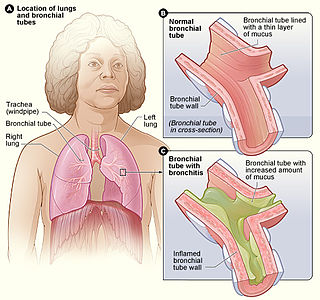
Soul Coughing was an American alternative rock band composed of vocalist/guitarist Mike Doughty, keyboardist/sampler Mark Degli Antoni, bassist Sebastian Steinberg, and drummer Yuval Gabay. Soul Coughing developed a devout fanbase and garnered largely positive response from critics. Steve Huey of AllMusic described the band as "one of the most unusual cult bands of the 1990s..." driven by frontman Mike Doughty's stream-of-consciousness poetry. Soul Coughing's sound was a willfully idiosyncratic mix of improvisational jazz grooves, oddball samples, hip hop, electronics, and noisy experimentalism". Doughty himself described the band's sound as "deep slacker jazz". The group broke up in 2000.

The common cold or the cold is a viral infectious disease of the upper respiratory tract that primarily affects the respiratory mucosa of the nose, throat, sinuses, and larynx. Signs and symptoms may appear fewer than two days after exposure to the virus. These may include coughing, sore throat, runny nose, sneezing, headache, and fever. People usually recover in seven to ten days, but some symptoms may last up to three weeks. Occasionally, those with other health problems may develop pneumonia.

Whooping cough, also known as pertussis or the 100-day cough, is a highly contagious, vaccine-preventable bacterial disease. Initial symptoms are usually similar to those of the common cold with a runny nose, fever, and mild cough, but these are followed by two or three months of severe coughing fits. Following a fit of coughing, a high-pitched whoop sound or gasp may occur as the person breathes in. The violent coughing may last for 10 or more weeks, hence the phrase "100-day cough". The cough may be so hard that it causes vomiting, rib fractures, and fatigue. Children less than one year old may have little or no cough and instead have periods where they cannot breathe. The incubation period is usually seven to ten days. Disease may occur in those who have been vaccinated, but symptoms are typically milder.

A cough is a sudden expulsion of air through the large breathing passages which can help clear them of fluids, irritants, foreign particles and microbes. As a protective reflex, coughing can be repetitive with the cough reflex following three phases: an inhalation, a forced exhalation against a closed glottis, and a violent release of air from the lungs following opening of the glottis, usually accompanied by a distinctive sound.

Cold medicines are a group of medications taken individually or in combination as a treatment for the symptoms of the common cold and similar conditions of the upper respiratory tract. The term encompasses a broad array of drugs, including analgesics, antihistamines and decongestants, among many others. It also includes drugs which are marketed as cough suppressants or antitussives, but their effectiveness in reducing cough symptoms is unclear or minimal.

Acute bronchitis, also known as a chest cold, is short-term bronchitis – inflammation of the bronchi of the lungs. The most common symptom is a cough. Other symptoms include coughing up mucus, wheezing, shortness of breath, fever, and chest discomfort. The infection may last from a few to ten days. The cough may persist for several weeks afterward with the total duration of symptoms usually around three weeks. Some have symptoms for up to six weeks.

Charles William Ingram is an English fraudster, novelist and former British Army major who gained notoriety for his appearance on the ITV television game show Who Wants to Be a Millionaire? In episodes recorded in September 2001, Ingram correctly answered fifteen questions to win the show's maximum prize of £1 million, becoming the third recorded contestant to ever do so. However, he was denied the winnings due to suspicion of cheating.

Benadryl is a brand of various antihistamine medications used to stop allergies, whose content varies in different countries, but which includes some combination of diphenhydramine, acrivastine, and/or cetirizine.
ATC code R05Cough and cold preparations is a therapeutic subgroup of the Anatomical Therapeutic Chemical Classification System, a system of alphanumeric codes developed by the World Health Organization (WHO) for the classification of drugs and other medical products. Subgroup R05 is part of the anatomical group R Respiratory system.

Guaifenesin, also known as glyceryl guaiacolate, is an expectorant medication taken by mouth and marketed as an aid to eliminate sputum from the respiratory tract. Chemically, it is an ether of guaiacol and glycerine. It may be used in combination with other medications. A 2014 study found that guaifenesin has no effect on sputum production or clearance in upper respiratory infections.
Benzonatate, sold under the brand name Tessalon among others, is a medication that is used for the symptomatic relief of cough. A 2023 systematic review found that there is inadequate evidence to support the effectiveness and safety of benzonatate for cough and highlighted rising safety concerns. Benzonatate is taken by mouth. Effects generally begin within 20 minutes and last 3 to 8 hours.

Dextromethorphan (DXM) is a cough suppressant used in many cough and cold medicines. It affects serotonin, norepinephrine, NMDA, and sigma-1 receptors in the brain, all of which have been implicated in the pathophysiology of depression. In 2022, the FDA approved a formulation of it combined with bupropion named Auvelity to serve as a rapid acting antidepressant in patients with major depressive disorder.

A throat lozenge is a small, typically medicated tablet intended to be dissolved slowly in the mouth to temporarily stop coughs, lubricate, and soothe irritated tissues of the throat, possibly from the common cold or influenza. Cough tablets have taken the name lozenge, based on their original shape, a diamond.

Halls is a British brand of a mentholated cough drop owned by Mondelēz International since 2015. In 2016, it was one of the biggest selling branded over-the-counter medications sold in Great Britain, with sales of £32.5 million.

Bordetella pertussis is a Gram-negative, aerobic, pathogenic, encapsulated coccobacillus of the genus Bordetella, and the causative agent of pertussis or whooping cough. Like B. bronchiseptica, B. pertussis can express a flagellum-like structure, even if it has been historically categorized as a nonmotile bacteria. Its virulence factors include pertussis toxin, adenylate cyclase toxin, filamentous hæmagglutinin, pertactin, fimbria, and tracheal cytotoxin.

Lean, also known as purple drank, purp, sizzurp, syrup, and several other names, is a recreational drug beverage, prepared by mixing prescription-grade cough or cold syrup containing codeine and promethazine with a soft drink. The beverage originated in Houston and is popular in hip hop culture, especially within the Southern United States.

Levodropropizine is a cough suppressant. It is the levo isomer of dropropizine. It acts as a peripheral antitussive, with no action in the central nervous system. It does not cause side effects such as constipation or respiratory depression which can be produced by opioid antitussives such as codeine and its derivatives.

Dropropizine is a cough suppressant that is sold in Germany, Central America, South America, and some African countries such as Congo. It is sold as suppositories, tablets, and syrup. It is used to stop a cough caused by allergies or a cold.

Dibunate is a cough suppressant. As the sodium salt, it has been marketed under the name Becantyl, Becantex, or Linctussal with a dosage of 20 to 30 mg, as either syrup or tablets.

Bronchitis is inflammation of the bronchi in the lungs that causes coughing. Bronchitis usually begins as an infection in the nose, ears, throat, or sinuses. The infection then makes its way down to the bronchi. Symptoms include coughing up sputum, wheezing, shortness of breath, and chest pain. Bronchitis can be acute or chronic.
















